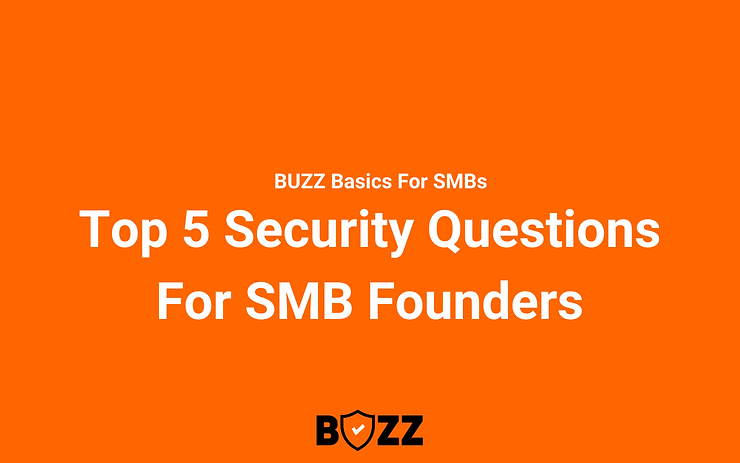Imagine asking your team, “Are we developing according to security standards? Are we secure?” and receiving a confident “Of course” in return.
The truth behind such assurances often surfaces during a security breach, a compliance audit, a Vulnerability Assessment and Penetration Testing (VAPT), or when a bug bounty hunter reveals your own data and access vulnerabilities. The aftermath can be financially and reputationally damaging, with recovery potentially being a long and expensive journey.
While cybersecurity is a vast domain, let’s explore the top 5 pivotal questions to initiate your journey toward a secure business environment, encouraging you to dig deeper as you explore.
Top 5 Security Questions
#1. Is Our Data Safe?
This question probes the measures in place to safeguard your data against unauthorized access and potential breaches.
Beware of Responses Like –
- “We use default encryption settings.”
- “We don’t need MFA, passwords are strong enough.”
- “We store backups on the same network.”
Why Be Wary?
Default encryption settings may not align with your specific security needs. Sole reliance on passwords, even strong ones, leaves a vulnerability window, and storing backups on the same network poses a risk of losing them during network breaches.
What Can You Do?
- Advanced Encryption: Utilize a robust secret code for your data, making it difficult for unauthorized parties to decipher.
- Multi-Factor Authentication (MFA): Implement a two-step verification process, enhancing security by requiring an additional verification step after entering the password.
- Separate Backup Storage: Ensure backups are stored in a different, secure location to safeguard them against network breaches.
#2. Who Has Access?
This pertains to the management and monitoring of who can access your data and systems.
Beware of Responses Like –
- “We don’t differentiate access levels.”
- “We don’t regularly review access lists.”
- “We don’t track data access or modifications.”
Why Be Wary?
Lack of differentiated access means individuals may have unnecessary access to sensitive data. Without regular reviews and tracking, unauthorized or outdated access may go unnoticed.
What Can You Do?
- Role-Based Access: Assign access based on roles to ensure individuals access only the data relevant to their work.
- Periodic Access Reviews: Regularly check and update access lists to prevent unauthorized access.
- Data Access Tracking: Utilize tools that log and alert for any unauthorized data access or modifications.
#3. What If We Get Hacked?
This explores your preparedness and response plan in the event of a cybersecurity incident.
Beware of Responses Like –
- “We’ll know when customers complain.”
- “We’ll just restore from a backup.”
- “We’ll change passwords and it’ll be fine.”
Why Be Wary?
Relying on customer complaints as a breach alert system is reactive and damaging. Sole reliance on backups and password changes post-breach may not address the root cause or extent of the breach.
What Can You Do?
- Incident Response Plan: Create a detailed plan outlining actions during a breach, ensuring a quick and organized response.
- Continuous Monitoring: Employ security tools that continuously check your systems for unusual activities and provide alerts for any potential breaches.
- Backup and Restore Strategy: Ensure your backup system can quickly restore data in case of loss, ensuring business continuity.
#4. Are Our Systems Updated?
This questions the regularity and methodology of updating your systems and software.
Beware of Responses Like –
- “We update when the system prompts us.”
- “We avoid updates to prevent downtime.”
- “We update manually when we remember.”
Why Be Wary?
Infrequent or manual updates can leave systems vulnerable to known issues that have been patched in newer versions.
What Can You Do?
- Automated Updates: Enable automatic updates to ensure you’re always using the latest, most secure versions.
- Scheduled Update Checks: Regularly check for updates even with automation to ensure all systems and software are up-to-date.
- Rollback Plan: Have a plan to revert systems back to a previous state in case an update causes issues, ensuring minimal disruption to operations.
#5. Are 3rd Party Tools Secure?
This assesses the security vetting process for third-party tools and services utilized by your business.
Beware of Responses Like –
- “We assume popular tools are secure.”
- “We haven’t read their security documentation.”
- “We don’t have a dedicated team to assess tools.”
Why Be Wary?
Assumptions about security can be dangerous. Lack of knowledge about a tool’s security features and not having dedicated personnel for assessment can expose you to risks.
What Can You Do?
- Security Assessments: Thoroughly check third-party tools for security features and any history of breaches before use.
- Understanding Security Documentation: Ensure at least one team member understands the tool’s security setup and can ensure it aligns with your needs.
- Dedicated Personnel: Consider having a team member or external consultant focusing on assessing and ensuring the security of the tools and platforms you use.
To Conclude
Embarking on a cybersecurity journey requires a meticulous approach to questioning and understanding the security posture of your business. While the above questions serve as a starting point, the path to cybersecurity is continuous and evolving. Ensure that your questions are specific, your skepticism healthy, and your approach proactive to safeguard your business in the digital realm.
Ask Specific Security Questions!
For more insights, tutorials, and a community of security-aware developers, visit BUZZ. Together, we will make security accessible to all!




